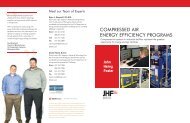The Turbo Air® 3000 Centrifugal Compressor Compressor Handbook
The Turbo Air® 3000 Centrifugal Compressor Compressor Handbook
The Turbo Air® 3000 Centrifugal Compressor Compressor Handbook
Create successful ePaper yourself
Turn your PDF publications into a flip-book with our unique Google optimized e-Paper software.
<strong>The</strong> <strong>Turbo</strong> Air <strong>3000</strong> <strong>Centrifugal</strong> <strong>Compressor</strong> Operator’s Manual<br />
Alarm and Trip Functions<br />
If compressor-operating parameters deviate from normal tolerances, the Vantage Control System will<br />
activate one of two levels of compressor protection.<br />
6—6<br />
Alarm. An Alarm condition is a warning about a compressor operating condition that is<br />
outside of normal operating limits. <strong>The</strong> Alarm is intended to alert the operator to a condition that<br />
merits investigation, but does not present an immediate danger, or prevent the compressor from<br />
operating.<br />
Trip. A Trip condition is a protective measure initiated by the controller to safeguard the<br />
compressor. A compressor Trip condition requires immediate troubleshooting and correction<br />
before the compressor can be safely put back into operation.<br />
In either instance, when an abnormal condition occurs, the Vantage Control Panel will automatically<br />
revert to the Protection History Screen where the most recent event will be positioned at the top of<br />
the screen indicating date, time, type, description, instrument tag number, and data involved in the<br />
event.<br />
Operator Response to an Alarm or Trip Condition<br />
In the case of a compressor Alarm or Trip condition, the operator should respond as follows:<br />
1. Identify and assess the nature of the Alarm or Trip message that appears on the control panel<br />
display.<br />
2. Press the Home, View, History, or Network key to acknowledge the alarm and to turn off any<br />
external devices installed to alert the operator. <strong>The</strong> source of the alarm is maintained in the<br />
Protect History file for future review.<br />
3. Press the View key and use the Up or Down keys to select the Protection (Running) screen.<br />
4. Press the Enter to open the screen. Review the current monitoring point information and its<br />
relationship to the Alarm and Trip set points.<br />
5. Analyze the information, and then take any appropriate action(s) as required to prevent further<br />
deterioration of the Alarm condition to a dangerous level. In the case of a Trip condition, it is<br />
necessary to correct the cause of the Trip before attempting to restart the compressor.<br />
Example<br />
<strong>The</strong> next sample screen shows a representative Alarm message, in this instance signaling abnormal oil<br />
pressure.<br />
Operator Response<br />
With the Protection History screen being displayed on the control panel, the operator should:<br />
1. Take note of the actual oil pressure as displayed under the Data column.<br />
2. Press the View key and use the Up or Down keys to select the Protection (Running) screen.



